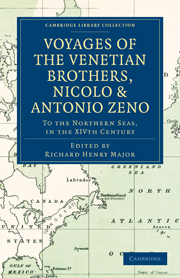 Voyages of the Venetian Brothers, Nicolò and Antonio Zeno, to the Northern Seas, in the XIVth Century
Voyages of the Venetian Brothers, Nicolò and Antonio Zeno, to the Northern Seas, in the XIVth Century APPENDIX: DESCRIPTION OF GREENLAND IN THE FOURTEENTH CENTURY
Published online by Cambridge University Press: 05 November 2011
Summary
It is reported by men of experience, natives of Greenland, and recently come from thence, that from Stad in Norway to Horn on the east coast of Iceland, is seven days sailing due west. From Snaefjeldsnaes in Iceland, from which point the passage to Greenland is the shortest, the course is two days and two nights due west, and there you will find Gunnbjorn's Rocks midway between Greenland and Iceland. In old times this was the customary route, but now the ice that has been brought down from the northern recess of the ocean, has adhered so closely to the abovenamed rocks that no one can hold the ancient course without placing his life in danger. From Long-naes, the northernmost point in Iceland near the above-named Horn, is two days' and two nights' sail to Svalbard in Havsbotnis. They who wish to sail direct from Bergen in Norway, to Greenland without touching Iceland, must sail due west, until they find themselves twelve nautical miles south of Reykianaes, a promontory on the south coast of Iceland, and by continuing this coast to the westward they will come to the high land of Greenland, called Hvarf. A day before you sight the said Hvarf, you ought to see another lofty mountain called Hvidserk; under the two said mountains named, Hvarf and Hvidserk, is a headland named Herjulfsnaes, near which is a harbour named Sandhavn, which is frequented by Norwegians and merchants.
- Type
- Chapter
- Information
- Voyages of the Venetian Brothers, Nicolò and Antonio Zeno, to the Northern Seas, in the XIVth CenturyComprising the Latest Known Accounts of the Lost Colony of Greenland; and of the Northmen in America before Columbus, pp. 37 - 54Publisher: Cambridge University PressPrint publication year: 2010First published in: 1873
